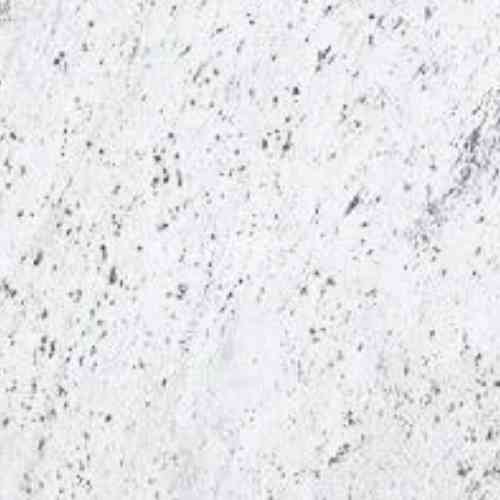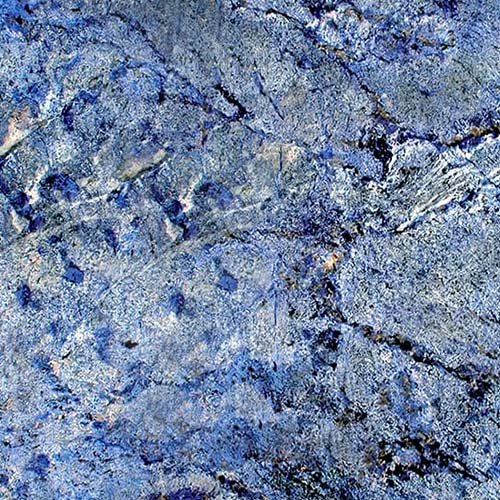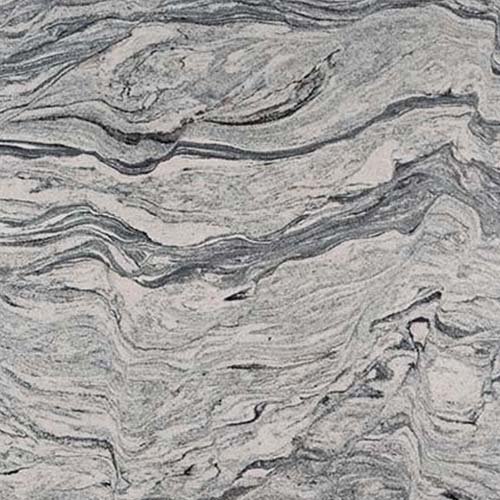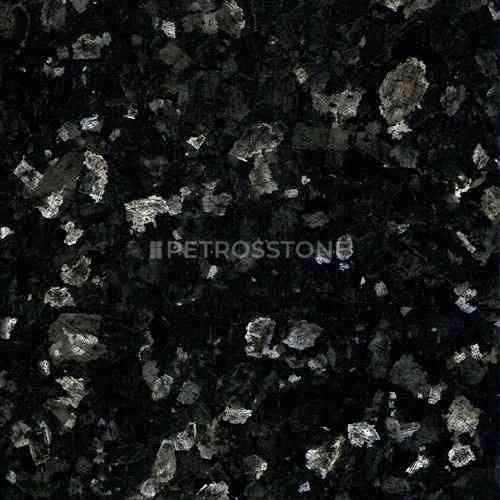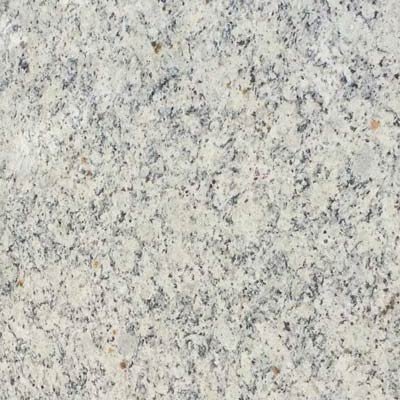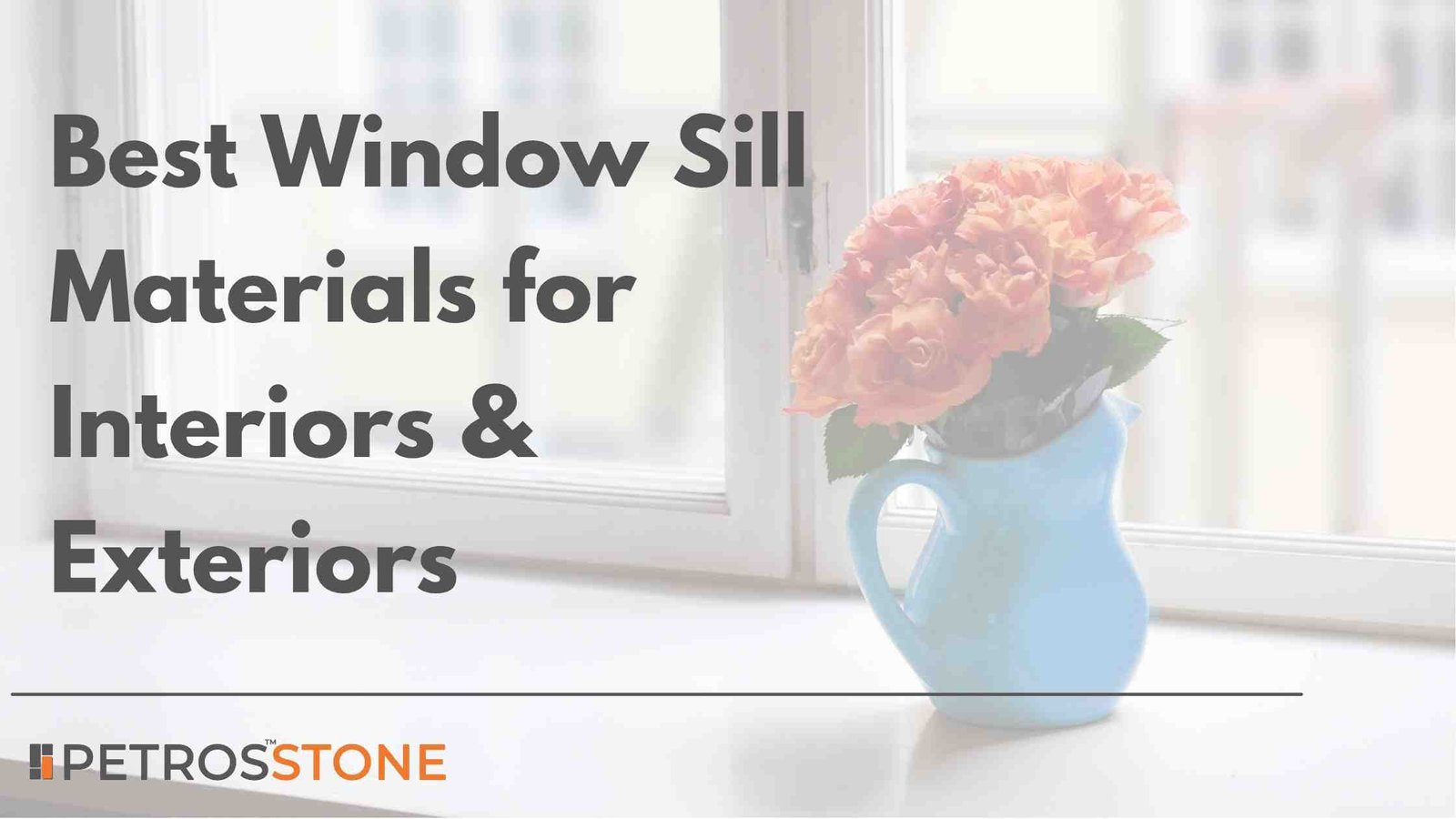
In this article we will look at the best materials for interior and exterior window sills.
Granite, Marble and natural stone are the most versatile window sill/window jamb material that can be used interior and for exteriors. Stone window sills strike perfect balance of luxury and durability making them the best window sill materials.
We will also look at some other materials that can also work for your project.
Though you may consider window sills an afterthought in design terms, they are very important to your home. These are more than just a plant or photo frame; they’re more than that. They even insulate your walls, improve the look of your windows and protect your walls from dampness.
How does one choose the right material among many alternatives? The “best” material depends largely on where the sill is located (exterior versus interior), what room it’s in (a steamy bathroom or a living room?), what your budget is, and what approach you want to take.
You will learn about the materials, price, and performance of window sills in your home.
- Best Window Sill Materials
- Best Interior Window Sill Materials
- Price of Interior Window Sills
- Pros and Cons of Each Interior Material
- Choosing Sills for Different Rooms (Interior)
- Exterior Window Sill Material Options
- Best Materials for Exterior Window Sills and Jambs
- Pros and Cons of Exterior Window Sill Materials
- Finding the Right Sill Material for You
- Standard Window Sill Thickness and Dimensions
- Window Sill Trim and Alternative Terminology:
- Need more Help?
- FAQs
Best Window Sill Materials
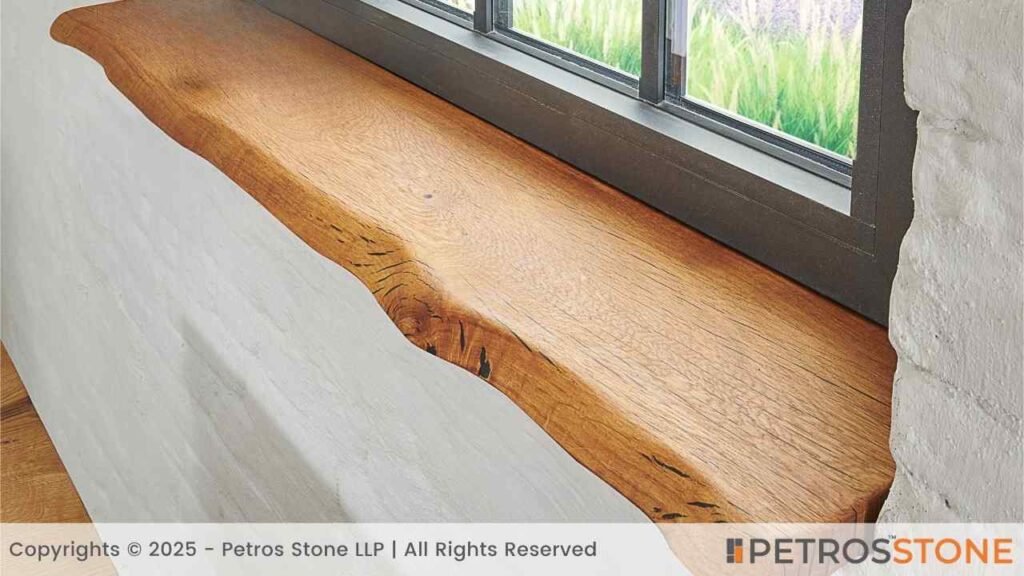
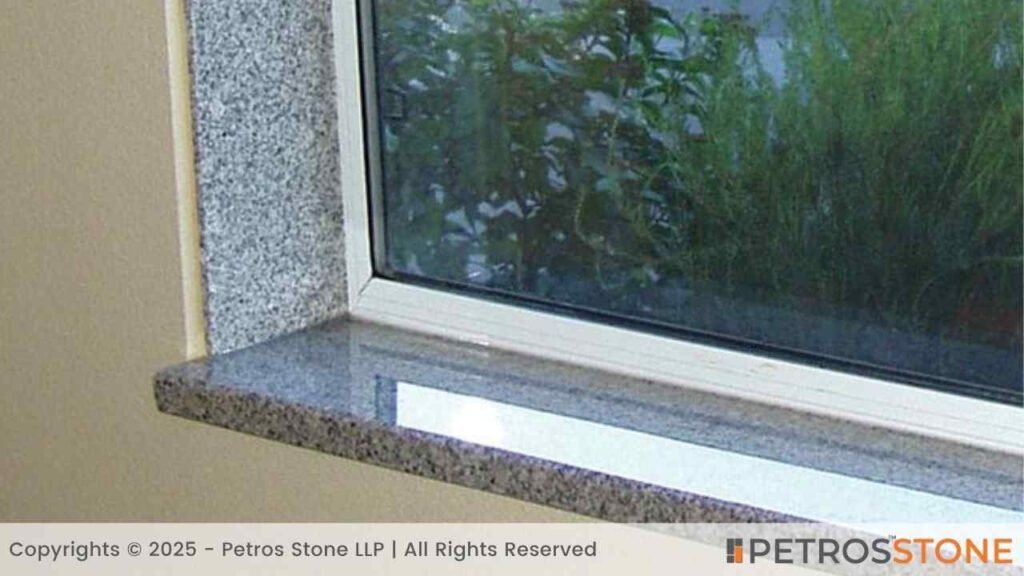
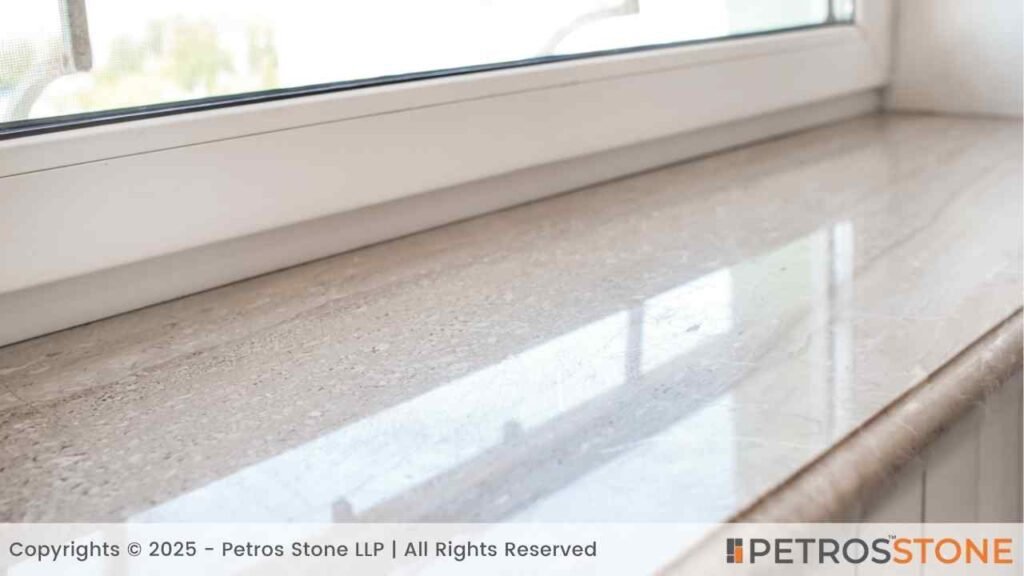
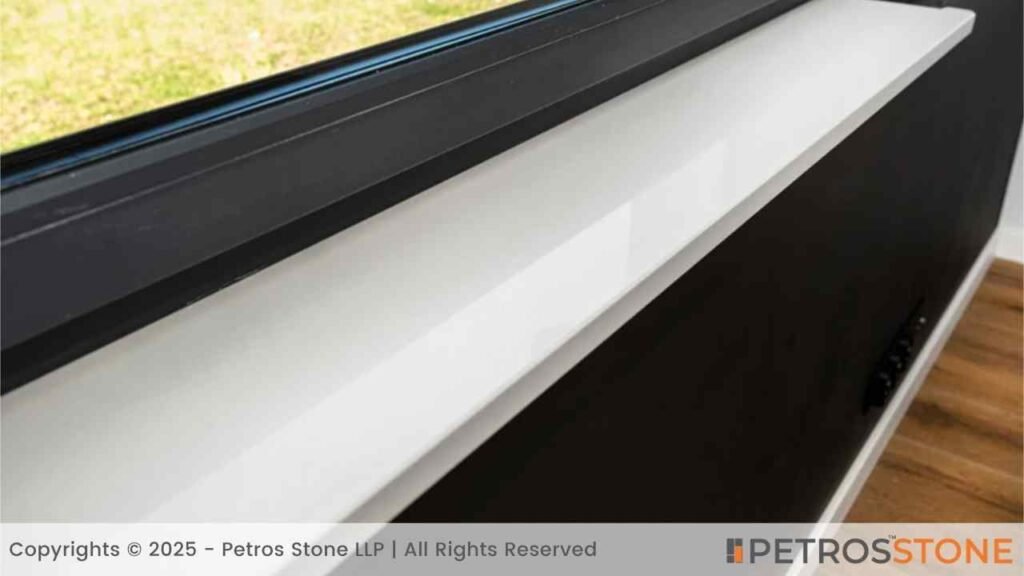
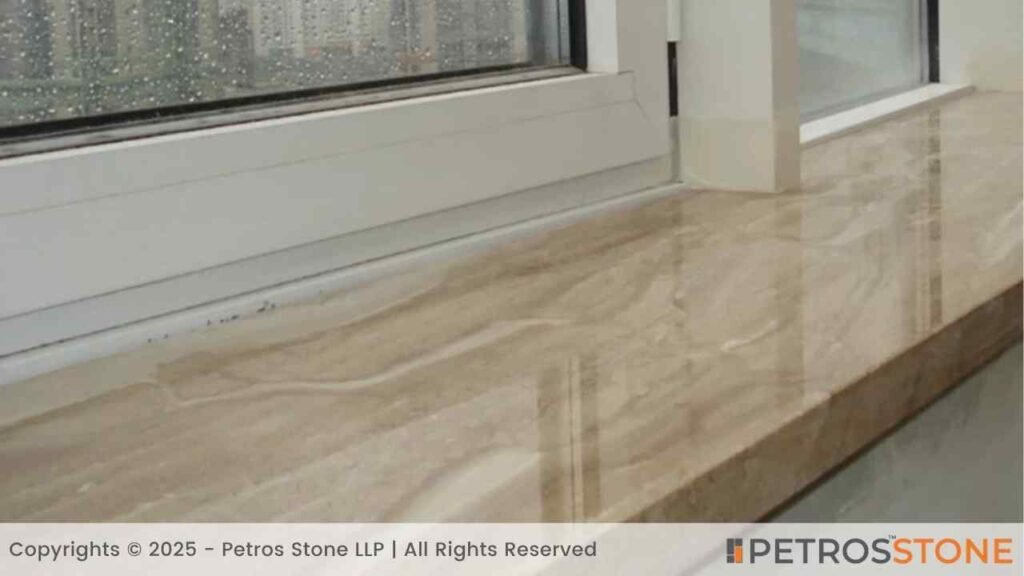

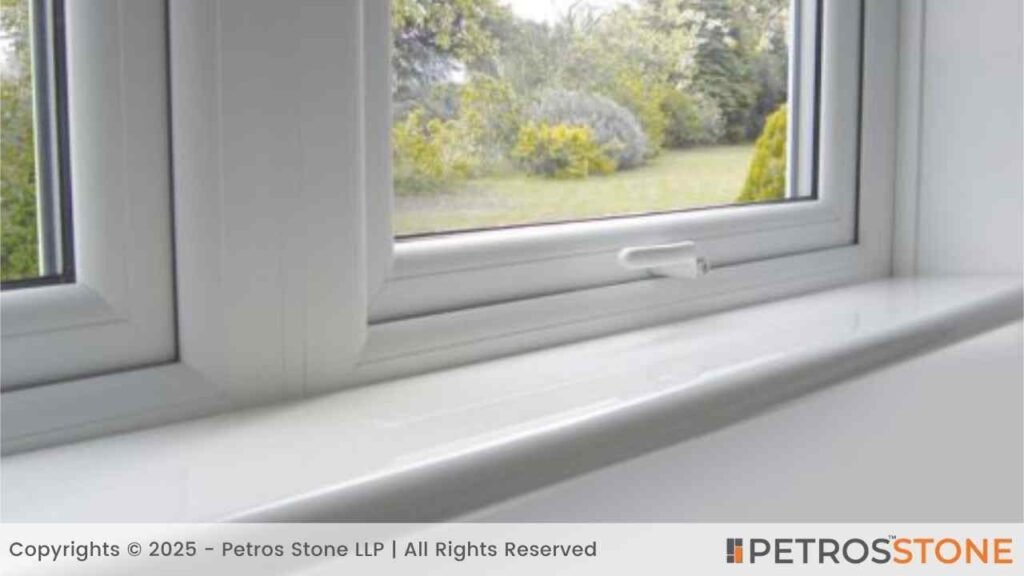
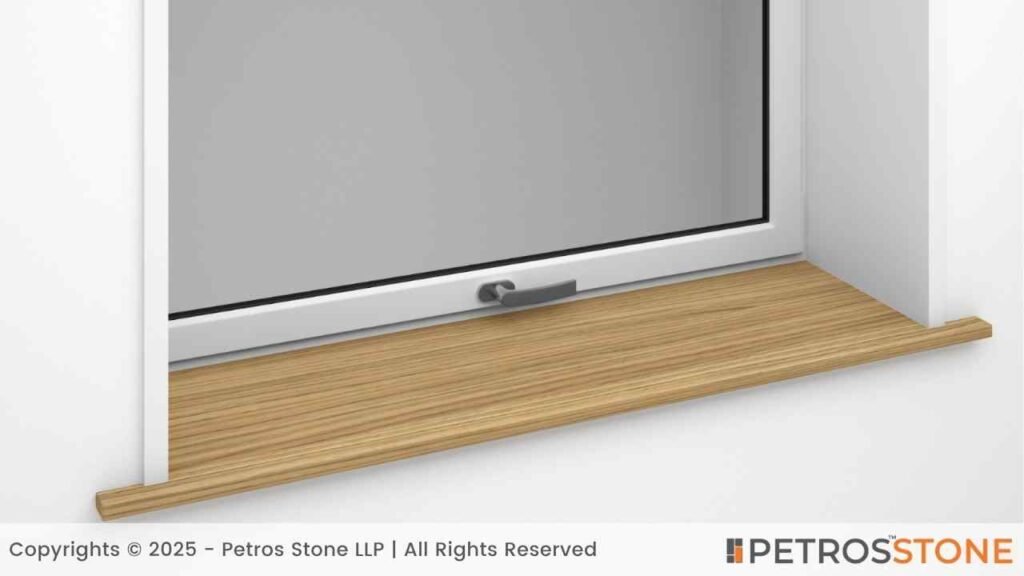
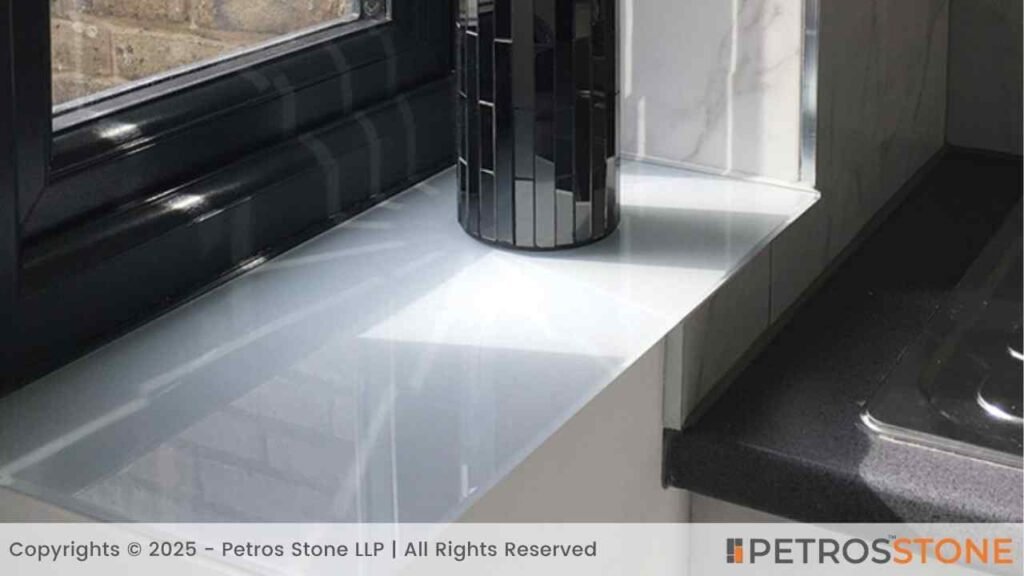
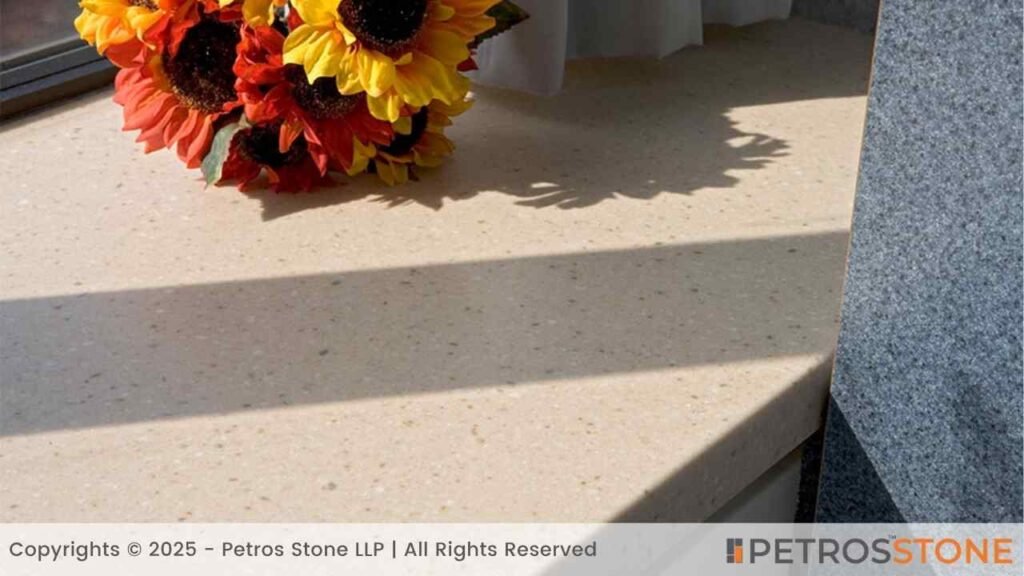
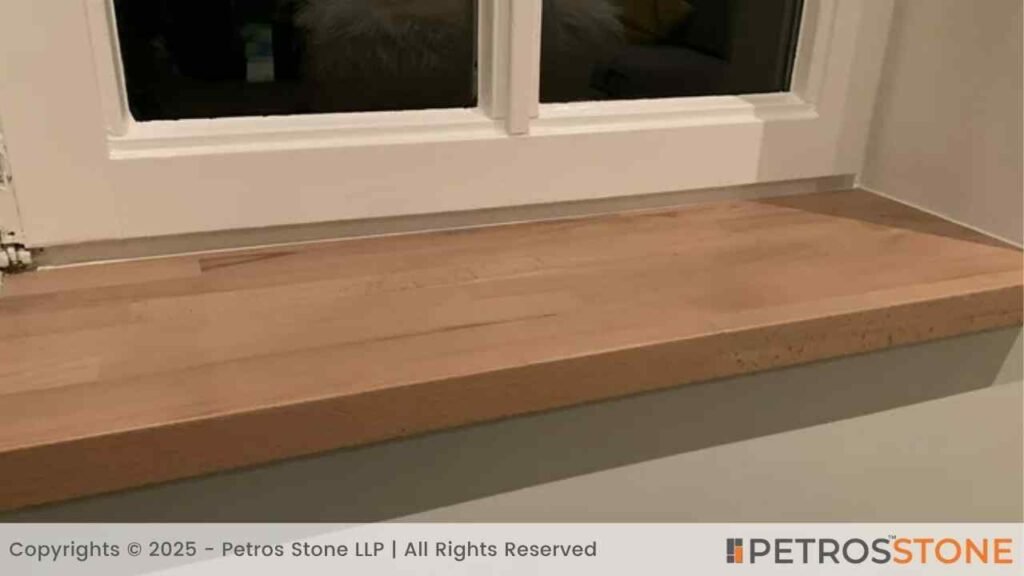
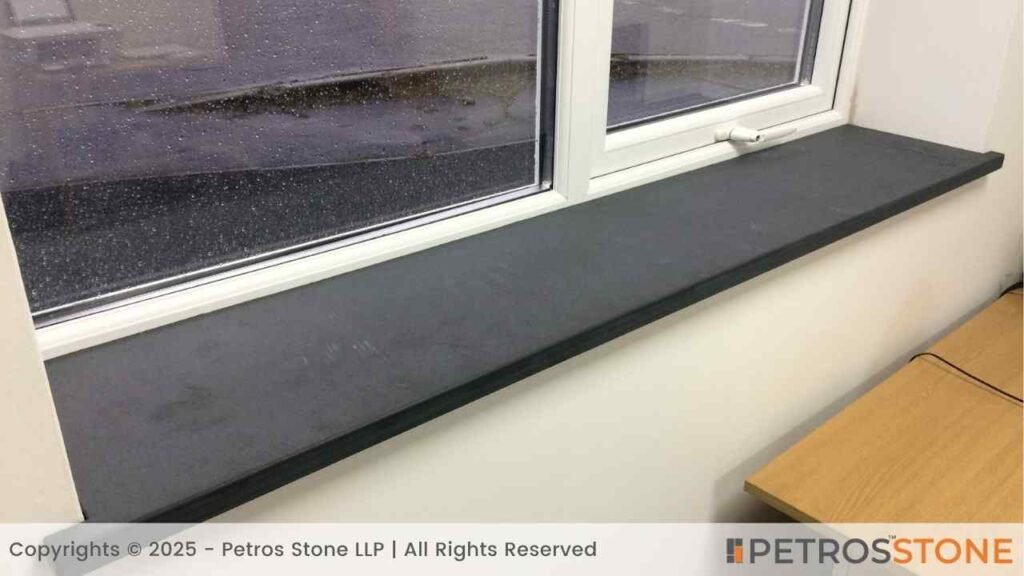
For Interior Window Sills, popular materials include:
- Wood (Oak, Pine, Beech, Mahogany, Maple, Chestnut)
- Granite
- Marble
- Quartz
- Composite/Engineered Marble
- Tile (Ceramic or Porcelain)
- PVC (Plastic)
- Laminated MDF (Medium Density Fiberboard)
- Concrete (and concrete composites)
- Glass
- Solid Surface (like Corian)
- Slate
For Exterior Window Sills, durability is key. Top choices are:
- Stone (Granite, Marble, Slate, Limestone)
- Metal (Aluminium, Steel)
- Concrete (Pre-cast or Poured)
- Brick
- Fiber Cement
- uPVC (Unplasticized Polyvinyl Chloride)
Now, let’s dive deeper into these options.
Best Interior Window Sill Materials
You have a wide array of choices for interior sills, each with its own character:
1. Woods (Oak, Maple, Mahogany, Beech, Maple, Chestnut)
A traditional way to warm a room. Yours may be stained or painted. Wood varieties vary in toughness and grain shape.

2. Granite
This variety is a very durable natural stone with excellent scratch resistance, available in various styles and patterns. It adds a certain luxury.

3. Marble
Another luxury natural stone with stylish veining and unique beauty. It is more delicate than granite and needs more care.

4. Engineered Stone
It is made of crushed quartz crystals and resin and is nonporous, tough, stain resistant and comes in many different styles and patterns – almost like natural Stone.

5. Composite Engineering Marble
An artificial material combining marble dust or chips with resin. It has a marble-like appearance and a much better stain resistance than natural marble-usually at a lower cost.

6. Tile
A versatile and often economical option is tile – ceramic or Porcelain. Tiles are made in several colors & designs and are water resistant.

7. Plastic (PVC)
This material is cheap and waterproof. This is useful & frequently used in utilitarian places or even when humidity is an issue.

8. Laminated MDF
Medium Density Fiberboard with decorative lamination layer at top. At a lower price it can mimic stone or wood but is susceptible to water damage when the laminate level is damaged.

9. Concrete and Concrete Composites
Offer a contemporary, industrial or minimalist look. This is colored or polished and may be poured in place or precast. This material is very tough.

10. Glass
It looks minimal, streamlined, and modern. Permits maximum light through and is easy to clean but delicate.

11. Solid Surfaces (e.g. Corian)
Manmade, seamless, nonporous components can take a variety of shapes. Durable and repairable.

12. Slate
A dark, sometimes matte natural stone. It is waterproof and tough.

Price of Interior Window Sills
Prices can vary hugely based on material quality, thickness, brand, customization, and your location. This table provides a general idea:
| Material | Indicative Price Range (per linear foot) | Photo | Description |
| PVC/uPVC | $5 – $20 |  | Plain white plastic sill, low-maintenance, moisture-resistant. |
| Laminated MDF | $10 – $25 |  | Wood-look laminate sill, durable, moisture-resistant. |
| Pine Wood | $15 – $40 |  | Light-colored wood sill, affordable, softwood. |
| Tile (Ceramic) | $12 – $45 (material only) |  | Tiled window sill, wide color range, installation extra. |
| Composite/Eng. Marble | $20 – $40 |  | Uniform marble-look sill, hard, impact-resistant, budget-friendly. |
| Oak/Maple Wood | $25 – $60 (oak) |  | Medium-toned hardwood sill, durable, premium look. |
| Quartz | $40 – $80 |  | Sleek quartz sill, non-porous, modern appearance. |
| Granite | $35 – $70 |  | Polished granite sill, natural stone, very durable. |
| Marble | $40 – $90 |  | Veined marble sill, luxury natural stone, classic look. |
| Concrete/Solid Surface | $20 – $50 (varies by customization) |  | Smooth concrete/Corian sill, customizable, modern. |
| Glass | $30 – $60 |  | Clear glass sill, contemporary, easy to clean. |
| Slate | $25 – $55 |  | Dark grey slate sill, natural stone, textured look. |
For detailed pricing, Chat with us.
Pros and Cons of Each Interior Material
Let’s weigh the good and the not-so-good for each window sill material.
| Material | Pros | Cons |
| Wood | Warm, natural look; can be painted/stained; various species/prices | Not for wet areas (can warp/rot); can scratch/dent; needs finishing/sealing |
| Granite | Extremely durable; scratch/heat resistant; many colors/patterns; luxurious | Can be expensive; cold to touch; needs sealing (though less than marble) |
| Marble | Unique, elegant beauty; luxurious feel | Expensive; porous (stains/etches easily); soft (scratches/chips); high maintenance |
| Quartz | Non-porous; highly durable; stain/scratch resistant; consistent look | Can be pricey; some types less heat resistant than granite; can look less natural |
| Composite/Eng. Marble | Marble look at lower cost; consistent; stain resistant; low maintenance | Less natural beauty than real marble; lower heat resistance |
| Tile (Ceramic/Porc.) | Water-resistant; durable; many styles/colors; budget-friendly option | Grout lines need cleaning/sealing; can chip/crack; cold to touch |
| PVC | Waterproof; low maintenance; very affordable; easy to clean | Can look less premium; may yellow/become brittle over time with UV exposure |
| Laminated MDF | Affordable; mimics wood/stone; easy to install | Not water-resistant (swells if laminate damaged); can chip/peel |
| Concrete/Composites | Very durable; modern/industrial look; customizable colors/finishes | Can be heavy; cold to touch; may require sealing; can be costly if custom |
| Glass | Sleek, modern; allows light; easy to clean | Fragile (can chip/break); shows fingerprints; can be expensive |
| Solid Surface | Non-porous; seamless look; repairable; many colors | Can scratch (though often buffable); can be damaged by high heat |
| Slate | Unique natural look; durable; water-resistant | Can be brittle/chip; limited color range (mostly dark); can be pricey |
Choosing Sills for Different Rooms (Interior)
The room’s function heavily influences the best material choice:
Best Bathroom Door and Window Sill Material
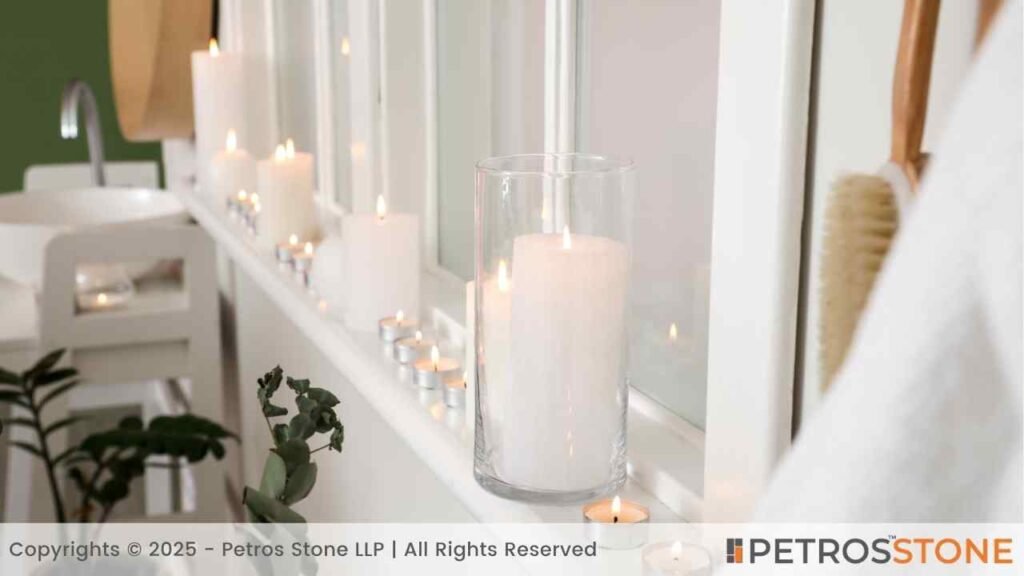
Moisture resistance is a must in any bathroom. You want a material that can endure humidity and water and not warp, rot, or stain. Examples of moisture-resistant materials include PVC, well-sealed granite or slate, porcelain tile, quartz, and composite marble. When the edges are completely sealed, laminated MDF may be used, though it is a much riskier choice. Don’t make use of unfinished wood.
Best Kitchen Window Sill Material
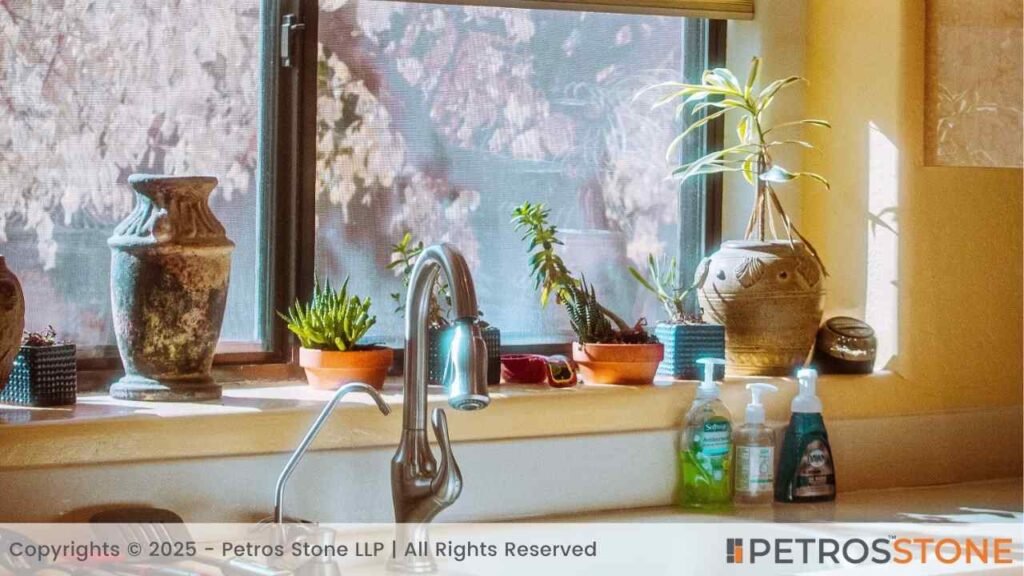
In the kitchen, You need to make use of sills, which are simple to clean up and will withstand some kind of abuse. You could choose PVC, composite marble, quartz, or natural stone. Laminate MDF will be usable if properly sealed, but spills are an issue and need quick attention.
Best Bedroom and Living Rooms Window Sill Material
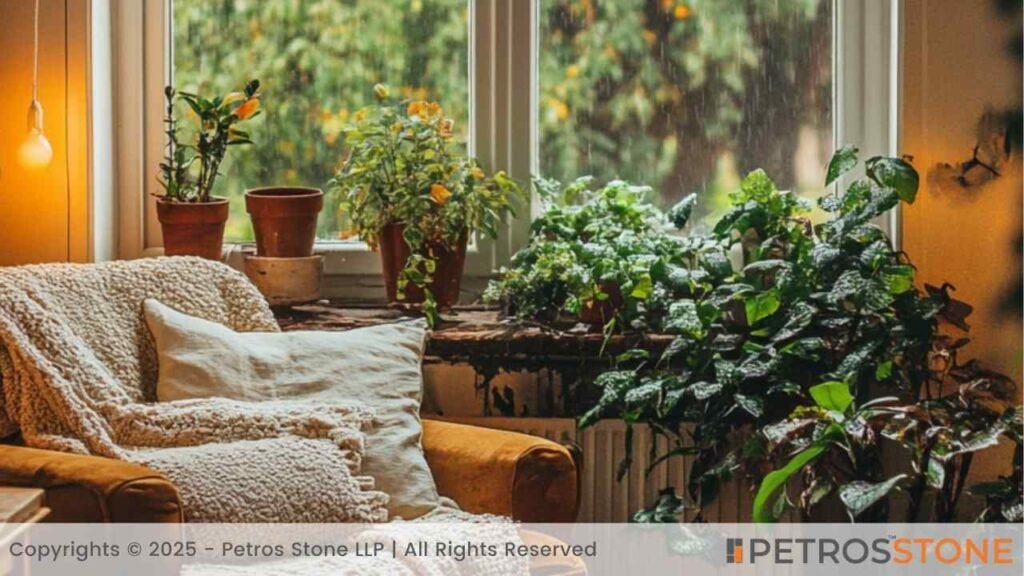
Here, Aesthetics frequently take center stage. You have more flexibility. Among the most widely used wood finishes would be wood (oak, maple, or pine), as it lends itself to a number of decor and it is warm. Natural stone (marble or granite) may provide a touch of luxury. Within these rooms, broad sills are perfect for displaying plants, decor, or books. In the event that moisture isn’t a problem, even painted MDF works.
Exterior Window Sill Material Options
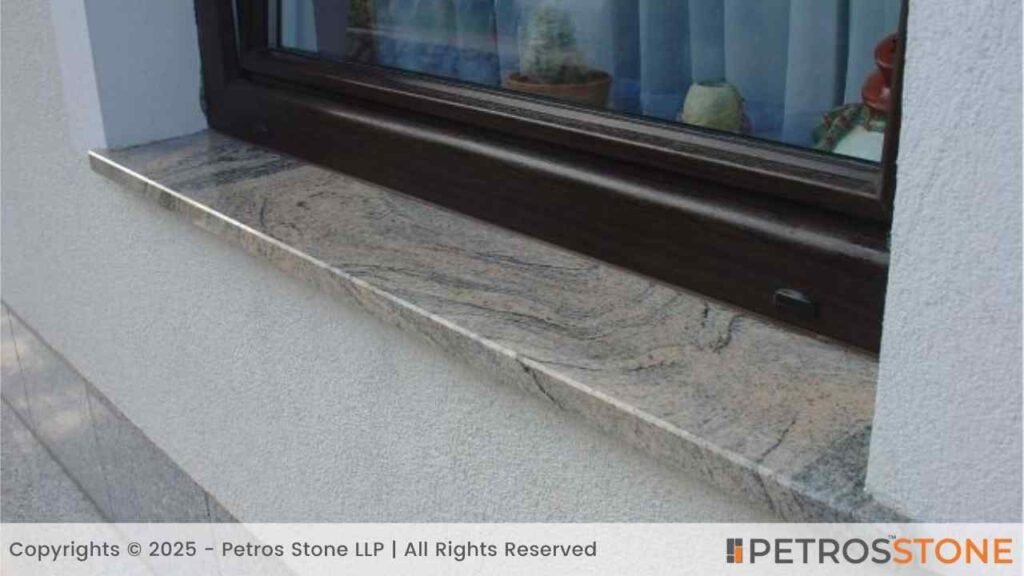
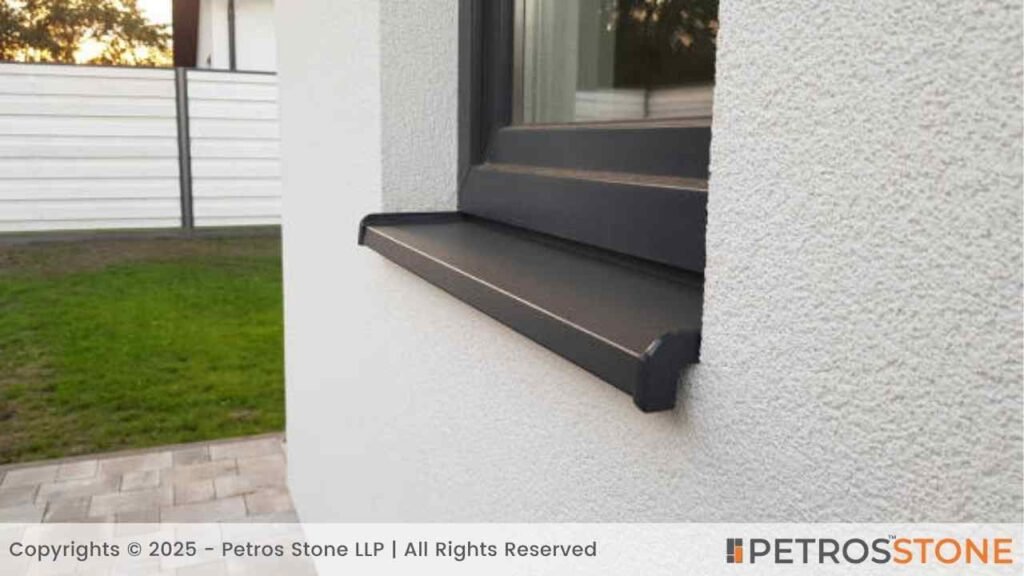

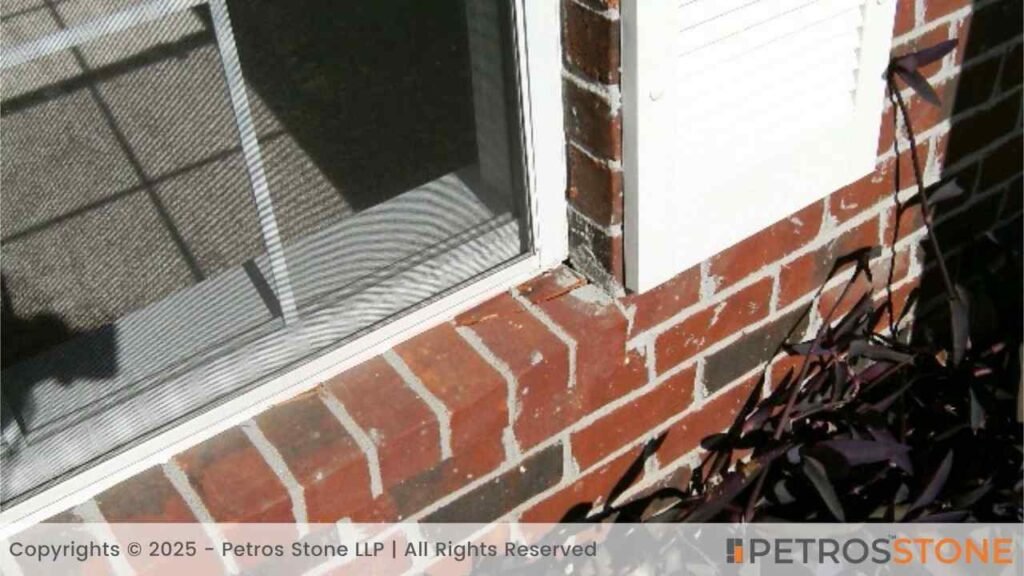
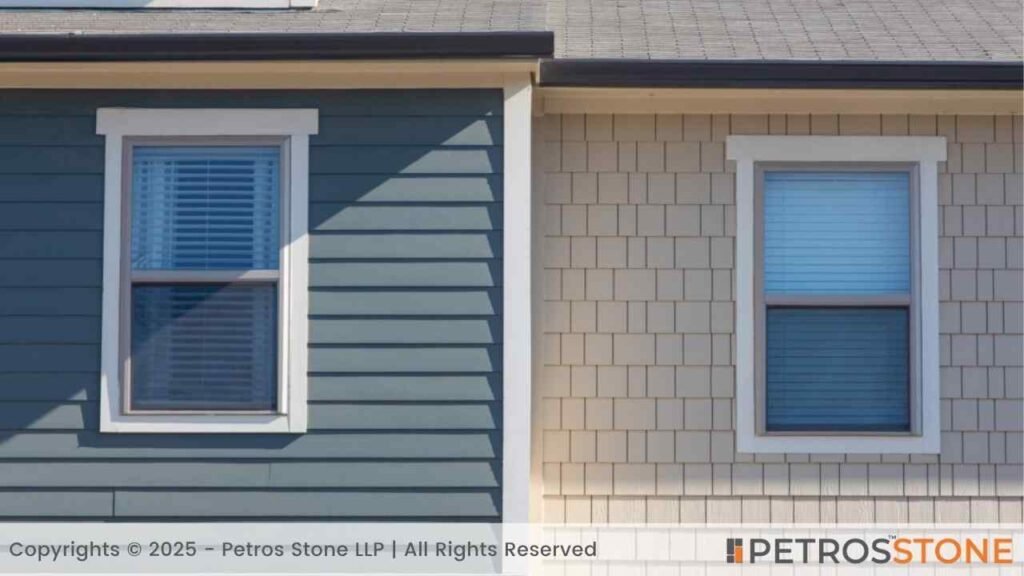

Exterior sills have a tough job. They need to direct rainwater away from the window and wall, withstand sun, rain, frost, and temperature changes, all while looking good.
Best Materials for Exterior Window Sills and Jambs
Durability and weather resistance are paramount:
- Granite, Slate, Marble, Limestone: Natural stone lasts very well and is very durable. Slate and granite are especially weather resistant. Both marble and limestone must be sealed further to keep their integrity but both stand the test of time.
- Metal (Aluminium, Steel): Often powder coated for color and/or corrosion resistance. Aluminum is light and will not rust. Steel needs the right finishing to avoid rust but is very strong. The sills are metal and look modern.
- Concrete (Pre-cast or Poured): Extremely durable and could be made into any shape or finish. The natural appearance allows painting or leaving it unpainted.
- Brick: This is a common & very durable choice often matched with brick-faced homes. The right installation will ensure proper drainage of the water.
- Fiber Cement: A combination of cellulose fibers, sand and cement. It can be painted and it resists decay, pests and fires.
- PVC/uPVC: Light and low maintenance and normally within your budget. It does not corrode or decay and it is resistant. The look and quality may differ from most architectural designs.
Pros and Cons of Exterior Window Sill Materials
| Material | Pros | Cons |
| Stone | Extremely durable; weather-resistant; premium look; long lifespan | Can be expensive; heavy (may need support); some stones need sealing |
| Metal | Durable; sleek/modern look; low maintenance (if finished well) | Can dent; steel can rust if coating damaged; can be noisy in rain |
| Concrete | Very durable; can be custom shaped/finished; relatively affordable | Heavy; can crack if not properly installed/cured; can look utilitarian |
| Brick | Highly durable; traditional aesthetic; matches brick homes | Can be porous (may need sealing); installation requires skill |
| Fiber Cement | Very durable; weather/rot/insect/fire resistant; paintable | Can be brittle before installation; requires specific cutting tools |
| PVC/uPVC | Waterproof; low maintenance; affordable; lightweight | Can look less premium; potential for UV degradation/brittleness over time |
Finding the Right Sill Material for You
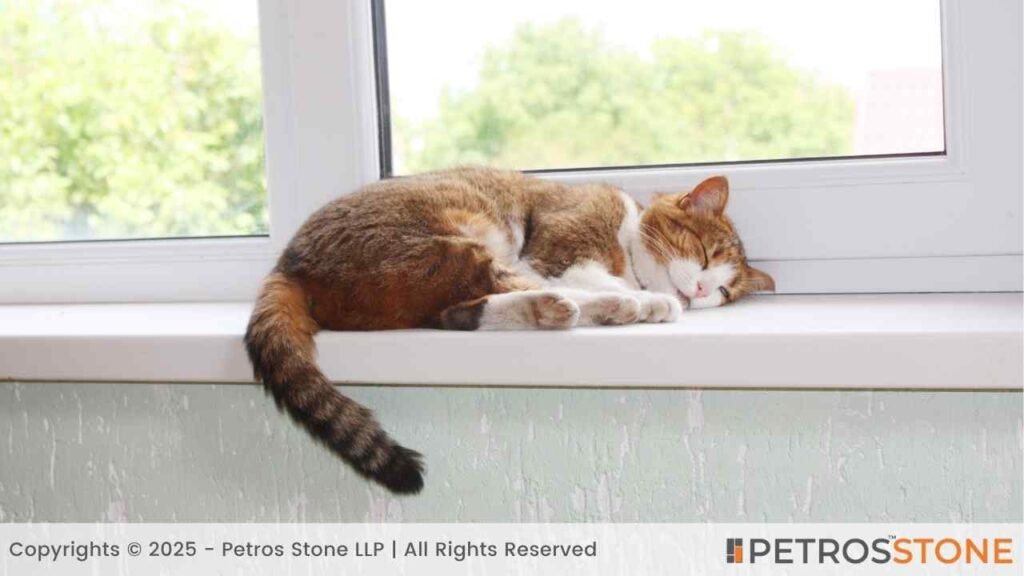
Choosing the best sill involves a mix of your design preferences, how the area is used, and your budget. Here are some general recommendations:
- High-end bathroom interior and exterior: Natural marble or granite (sealed)—beautiful and long-lasting. It also works well in high-end wet areas inside.
- Wet Areas—Low Budget (for example, a standard bathroom interior or utility exterior): PVC/uPVC comes in many colors and is useful, waterproof, and cheap. For the interior of your home, ceramic or porcelain tile is a cost-effective and waterproof option.
- Money Medium/Dry Areas/Unique Designs, like the inside of the living room: Wood is very warm and looks appealing in many differentappealings. For dry, low-impact areas with tight budgets, laminate MDF might work.
- Long-lasting and easy to care for materials for the outside are stone (granite or slate), concrete, or fiber cement.
- A modern, sleek exterior can be made of either metal (like aluminum) or smooth concrete.
- For a traditional look, brick or some kinds of stone work well.
Standard Window Sill Thickness and Dimensions
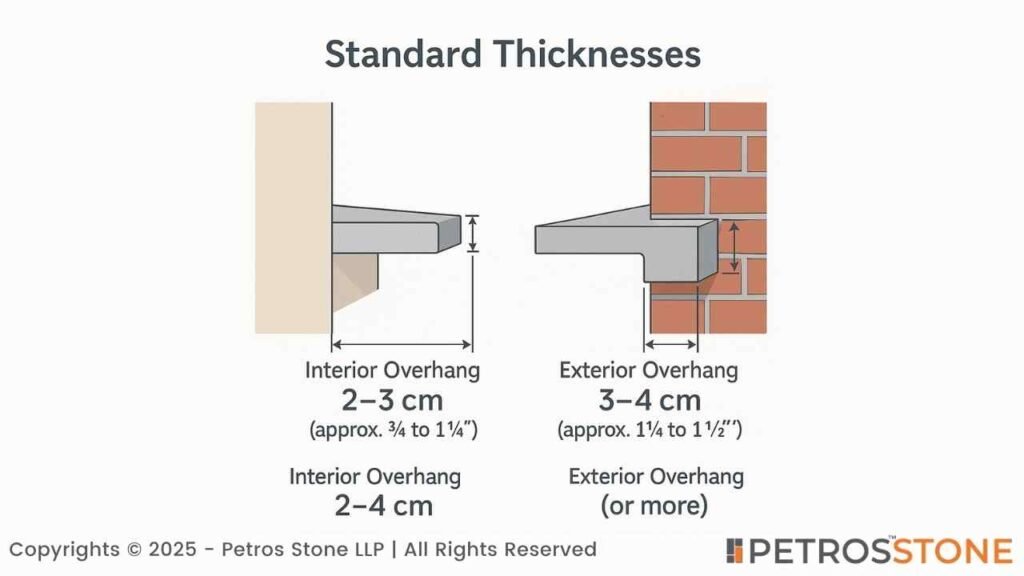
The size of your window sill matters for both appearance and function.
Standard Thicknesses
- Interior sills are usually between 20mm (about ¾ inch) and 30mm (about 1 ¼ inches) thick. 20mm is a common size for PVC or thinner wood/MDF, while 30mm is a common size for stone or thicker wood to give the look of being more substantial.
- Exterior sills: These are usually a little thicker, between 2 and 3 cm (20 and 30 mm), to make sure they last and let water run off properly. For bigger windows or a stronger architectural style, they can be up to 4 cm or more.
Width and Overhang Guidelines
- Interior Overhang: The part of the sill that extends past the wall surface into the room (often called the “stool”) typically overhangs by 2-3 cm (approx. ¾ to 1 ¼ inch) beyond the plaster or drywall. This creates a neat edge and a small usable ledge.
- Exterior Overhang: The exterior sill must overhang the facade by at least 3-4 cm (approx. 1 ¼ to 1 ½ inch) and should have a “drip edge” (a groove on the underside) to ensure rainwater drips clear of the wall, preventing staining and moisture damage.
- Custom Sizing: While there are standards, many window openings are unique. Custom sizing is often necessary, especially for older homes or unique architectural designs, to ensure a perfect fit.
Window Sill Trim and Alternative Terminology:

You might hear different terms used for window sills and their associated parts.
Common Terms for Window Sill & Trim
- Sill / Ledge / Shelf: These are often used interchangeably for the main horizontal part of the window sill. “Window ledge” or “window shelf” are common layman’s terms.
- Interior Trim Components:
- Stool: The part of the interior sill that projects into the room, forming the ledge.
- Apron: A horizontal piece of decorative trim installed on the wall directly beneath the stool.
- Exterior Trim Components:
- Window Trim / Casing: The moulding that goes around the sides and top of the window frame on the exterior.
- Drip Edge/Cap: A feature on the underside of the exterior sill’s overhang to direct water away.
Decorative and Functional Trim Elements
- The apron on an interior sill is primarily decorative, helping to finish the window opening visually.
- The stool provides usable ledge space.
- The casing or architrave (the molding around the window frame, both interior and exterior) frames the window and covers the gap between the window unit and the wall.
Need more Help?
Picking the right windowsill is more than picking a color. It all comes down to finding the right material and design for the window location (interior or exterior), the room’s function, your home style and your budget.
For interiors, you can range from warm woods to noble stones and robust synthetics and thereby focus on looks, toughness or resistance to moisture. For outsides, weather resistance and durability should come first, and stone, concrete, metal and fiber cement are good long-term materials.
Think about standard thicknesses and overhangs for function as well as appearance. With thoughtfulness toward these issues, you’ll choose window sills that look good and do their protective work for decades to come.
At Petrosstone, we don’t just offer premium-quality window sill materials—we help you choose the right style, finish, and type for your specific needs.
Chat with us now or explore our collection to find the perfect sill for your window.
FAQs
What is the most durable material for window sills?
For outside, natural stone (especially granite or slate), concrete, and fiber cement are very durable. For interiors, granite and quartz, as well as high-quality PVC or solid surface materials, are very durable.
Can I use the same material for both interior and exterior sills?
Occasionally, although not always. Materials including all-natural stone (granite, slate) can usually be used for both if properly selected and sealed for outside conditions. Nevertheless, many inside woods or maybe laminated MDF are unsuitable for exterior use as a result of water.
What thickness is best for window sills?
Interior sills are typically 20-30mm (¾” to 1 ¼”). Exterior sills are often 20-40mm (¾” to 1 ½”) for durability and proper water runoff.
Are there moisture-resistant options for bathrooms and kitchens?
Yes! PVC, porcelain/ceramic tile, quartz, well-sealed granite, slate, and composite/engineered marble are all excellent moisture-resistant choices for interior sills in these areas.
Are wood window sills still a good option?
Yes, for interior, dry areas, wood remains a beautiful and popular choice due to its warmth and versatility in finishing. However, it’s generally unsuitable for exteriors or very damp interiors like shower areas without exceptional sealing and maintenance.
What are some environmentally friendly window sill options?
Reclaimed wood, bamboo (a fast-growing grass), recycled glass composites, or locally sourced natural stone (reducing transport emissions) can be more eco-friendly choices. Look for FSC-certified wood.
Is it okay to not have any window sills?
While possible in some very modern, minimalist designs (often called a “picture frame” window return), traditional window construction usually includes sills. Exterior sills are crucial for weather protection. Interior sills protect the wall below the window and provide a finished look. Omitting them requires careful detailing to manage moisture and aesthetics.
Feel free to get in touch for a free consultation, quote, and get a detailed understanding from our experts here at Petros®. Visit https://petrosstone.com/ or call +91-8446360361 and WhatsApp

Hi, I’m Dhananjay,
With a background in architecture and years of industry experience, I share insights on materials that shape great design. At Petros® Stone, I craft content that highlights the beauty and utility of natural stone, helping architects, builders, and homeowners make informed choices while strengthening the brand’s voice and online presence.
Brown Granite
White Galaxy Granite
Blue Bahia Granite
Silver Cloud Granite
Black Pearl Granite
Dallas White Granite


